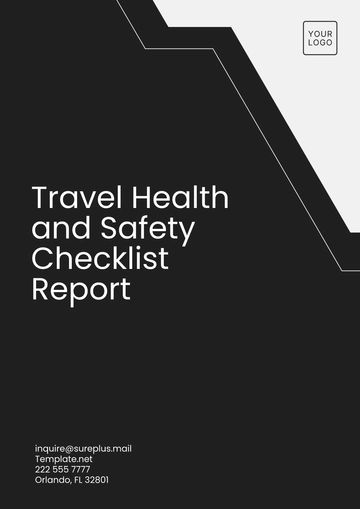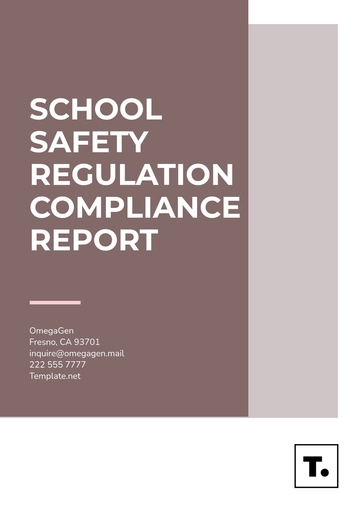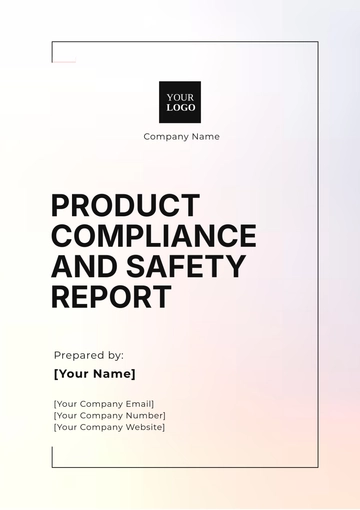Free Healthcare Safety and Infection Control Report

Prepared by: [Your Name]
Company: [Your Company Name]
Date: January 15, 2060
1. Introduction
This report outlines the current practices, assessments, and outcomes of healthcare safety and infection control within the healthcare facility. The objective is to ensure that both patient and staff safety is maintained and that the risk of healthcare-associated infections (HAIs) is minimized. The report reviews our infection control programs, evaluates their effectiveness, and provides recommendations for future improvements.
2. Objectives
The key objectives of the healthcare safety and infection control program are as follows:
Minimize the risk of healthcare-associated infections (HAIs) through effective prevention strategies.
Promote adherence to infection control protocols by healthcare staff.
Ensure compliance with regulatory standards and guidelines set by health authorities.
Educate staff on infection control practices and patient safety measures.
Monitor infection control outcomes and implement continuous improvements.
3. Infection Control Practices
The facility employs the following infection control practices:
Hand Hygiene: Mandatory hand hygiene training for all healthcare workers, with hand sanitizer stations placed throughout the facility. Regular audits ensure compliance.
Personal Protective Equipment (PPE): Proper use of PPE, such as gloves, gowns, and masks, is required for staff when interacting with patients or handling potentially contaminated materials.
Sterilization and Disinfection: All medical instruments are properly sterilized using autoclaves. High-touch areas, including patient rooms and operating theaters, are disinfected regularly.
Isolation Protocols: Patients diagnosed with infectious diseases are immediately isolated by facility guidelines to prevent cross-contamination.
4. Risk Assessment and Hazard Identification
High-Risk Areas: Operating rooms, intensive care units (ICUs), and emergency departments are identified as high-risk areas for infections due to the vulnerability of patients and the complexity of procedures.
Infection Surveillance: Regular surveillance of infection rates is conducted across various departments. An outbreak is reported immediately, and an investigation is initiated to identify the source.
Safety Hazards: There have been identified concerns in some areas such as needle-stick injuries, slips, trips, and falls. Regular safety audits and ergonomic assessments are conducted.
5. Compliance with Regulations and Standards
The healthcare facility adheres to guidelines set by the Centers for Disease Control and Prevention (CDC), World Health Organization (WHO), and Occupational Safety and Health Administration (OSHA).
Regular internal audits ensure compliance with these standards and regulatory requirements. Compliance with hand hygiene and sterilization standards has been consistently above 95%.
6. Staff Training and Education
Infection Control Training: Ongoing education is provided to all healthcare staff regarding infection prevention, proper PPE usage, and patient safety protocols.
Annual Refresher Courses: All staff are required to attend refresher courses on infection control and safety procedures at least once a year.
Staff Feedback and Engagement: Surveys are conducted annually to gauge staff understanding and satisfaction with the training programs, with feedback used to refine and improve future training.
7. Safety and Infection Control Outcomes
Infection Rates: In the past year, the overall healthcare-associated infection (HAI) rate has decreased by 15%, with significant reductions in central-line-associated bloodstream infections (CLABSI) and surgical site infections (SSI).
Safety Incidents: The number of safety-related incidents, such as falls and needle-stick injuries, has decreased by 10%. However, further efforts are needed in educating staff on proper handling of sharps and patient mobility assistance.
8. Challenges and Barriers
Staff Compliance: While hand hygiene compliance is high, some healthcare workers in non-patient care areas have been less consistent in following PPE protocols.
Resource Constraints: Limited resources, such as staff time and personal protective equipment during high-demand periods, have been a barrier to achieving optimal safety measures.
Staff Burnout: The ongoing pressures from high patient volumes have affected staff morale and adherence to infection control protocols.
9. Recommendations for Improvement
Increase PPE Availability: Ensure adequate supplies of personal protective equipment during peak times, particularly in high-risk areas.
Enhance Staff Engagement: Implement additional training to boost adherence to infection control protocols, with a focus on hand hygiene and PPE.
Strengthen Surveillance: Expand infection surveillance systems to include real-time monitoring of infection trends, which will allow for quicker interventions in outbreak situations.
Improve Safety Infrastructure: Increase the number of ergonomic and safety audits to reduce incidents of falls and needle-stick injuries.
10. Conclusion
The healthcare facility has made significant progress in reducing healthcare-associated infections and ensuring the safety of patients and staff. While challenges remain, particularly in resource management and staff adherence to infection control practices, the current safety measures and infection control protocols have proven effective in minimizing risks. Moving forward, the implementation of additional measures will continue to improve infection control and overall healthcare safety.
- 100% Customizable, free editor
- Access 1 Million+ Templates, photo’s & graphics
- Download or share as a template
- Click and replace photos, graphics, text, backgrounds
- Resize, crop, AI write & more
- Access advanced editor
The Healthcare Safety and Infection Control Report Template from Template.net is fully editable and customizable to meet your specific needs. Designed to streamline reporting, it allows you to modify key sections effortlessly. With the added convenience of being editable in our AI Editor Tool, you can easily personalize and update your reports with minimal effort.
You may also like
- Sales Report
- Daily Report
- Project Report
- Business Report
- Weekly Report
- Incident Report
- Annual Report
- Report Layout
- Report Design
- Progress Report
- Marketing Report
- Company Report
- Monthly Report
- Audit Report
- Status Report
- School Report
- Reports Hr
- Management Report
- Project Status Report
- Handover Report
- Health And Safety Report
- Restaurant Report
- Construction Report
- Research Report
- Evaluation Report
- Investigation Report
- Employee Report
- Advertising Report
- Weekly Status Report
- Project Management Report
- Finance Report
- Service Report
- Technical Report
- Meeting Report
- Quarterly Report
- Inspection Report
- Medical Report
- Test Report
- Summary Report
- Inventory Report
- Valuation Report
- Operations Report
- Payroll Report
- Training Report
- Job Report
- Case Report
- Performance Report
- Board Report
- Internal Audit Report
- Student Report
- Monthly Management Report
- Small Business Report
- Accident Report
- Call Center Report
- Activity Report
- IT and Software Report
- Internship Report
- Visit Report
- Product Report
- Book Report
- Property Report
- Recruitment Report
- University Report
- Event Report
- SEO Report
- Conference Report
- Narrative Report
- Nursing Home Report
- Preschool Report
- Call Report
- Customer Report
- Employee Incident Report
- Accomplishment Report
- Social Media Report
- Work From Home Report
- Security Report
- Damage Report
- Quality Report
- Internal Report
- Nurse Report
- Real Estate Report
- Hotel Report
- Equipment Report
- Credit Report
- Field Report
- Non Profit Report
- Maintenance Report
- News Report
- Survey Report
- Executive Report
- Law Firm Report
- Advertising Agency Report
- Interior Design Report
- Travel Agency Report
- Stock Report
- Salon Report
- Bug Report
- Workplace Report
- Action Report
- Investor Report
- Cleaning Services Report
- Consulting Report
- Freelancer Report
- Site Visit Report
- Trip Report
- Classroom Observation Report
- Vehicle Report
- Final Report
- Software Report





























